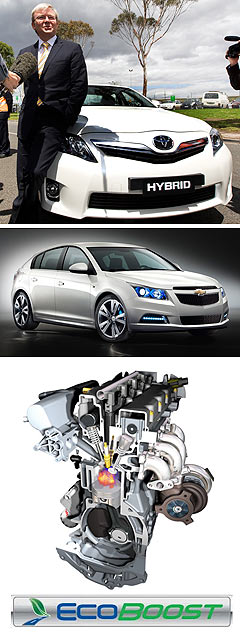News - General NewsCanberra takes $926 million chunk out of car industryAll over: Federal industry minister Senator Kim Carr and Toyota Australia president Max Yasuda in happier times, before the federal government put the axe through the Green Car Innovation Fund. Auto industry slams dumping of green car fund as a blow to local investment28 Jan 2011 THE Australian automotive industry will take a $926 million hit due to federal government funding cuts to pay for flood recovery. The industry is furious about the junking of the Green Car Innovation Fund, with Canberra siphoning off $429 million that had been earmarked to support development programs for Australian-built cars and automotive components on a one dollar for three dollars basis. The industry has urged the government to re-think the cuts, which it says might jeopardise projects already in the pipeline and drive them offshore to countries ready and willing to subsidise the cost to gain the business. Also scrapped is the so-called cash-for-clunkers scheme – officially called the Cleaner Car Rebate Scheme – which was to offer $2000 grants to coax drivers into trading in old, inefficient cars for new, greener vehicles. As well, the government will cap the number of grants for cars converted to LPG to 25,000 claims a year, slicing $96 million from the scheme over three years. The decision to axe the Green Car Innovation Fund comes just four days after federal industry and innovation minister Senator Kim Carr announced the latest grant from the fund, $3.5 million to help Melbourne-based Alternative Fuel Innovations develop an advanced new liquid LPG injection system for the local industry and export markets. But Mr Carr said all contractual commitments and grant offers made by the government through the fund would be honoured, and applications received by January 27 would be processed.  From top: Then prime minister Kevin Rudd launches the locally made Toyota Camry Hybrid, Holden's local Cruze hatch and Ford's EcoBoost four-cylinder turbo engine for Falcon. From top: Then prime minister Kevin Rudd launches the locally made Toyota Camry Hybrid, Holden's local Cruze hatch and Ford's EcoBoost four-cylinder turbo engine for Falcon.“The government’s commitment to Australia’s automotive industry is strong, and we recognise that manufacturing is a vital part of a strong and diverse economy,” he said. Mr Carrs cited the $3.4 billion Automotive Transformation Scheme as an example of the government’s continued commitment to the Australian motor industry – a message he said he would deliver to auto company CEOs when he visits their global headquarters later this year. The Green Car Innovation Fund had already been slashed by the government in the in the run up to last year’s federal election on the grounds that it had attracted fewer applications than originally expected. Describing the decision to chop it altogether as “bitterly disappointing and one to be regretted”, Federal Chamber of Automotive Industries chief executive Andrew McKellar told GoAuto the scrapping of the scheme sent a worrying signal to multinational companies looking to invest in Australia. “Up until now, there has been a lot of work done to highlight to those companies the strength of the policy arrangements here in Australia,” he said. “We went through a comprehensive review process in 2008 – submissions were received and all the stakeholders were consulted and the government put in place a plan for the next 10 years and beyond. And there was considerable certainty there. “When you get a decision like this, which comes less than three years after that review, it unfortunately pulls the rug out from the certainty. “Then it is much harder for anyone to convince those international investors that they have that certainty here in Australia.” Mr McKellar said the timing of the cuts was doubly bad because many companies that had been knocked down by the global financial crisis were finally in a financial position to invest in major programs for future products. “In the immediate aftermath of the GFC, there was great difficulty in getting global corporations to commit to new investment projects,” he said. “In the past 12 months or so, what we have seen is some new ideas coming into the pipeline and I am sure there are more on the way. “It is all the more reason why a decision such as this is disappointing, because it absolutely crucial that we do encourage new investment proposals to come forward and the new opportunities for low emissions technologies to be taken up in the Australian manufacturing context. “That is where the car plan arrangements are so important and why a program like the Green Car Innovation Fund was capable of delivering such benefits to the Australian industry.” All three Australian car-makers – Holden, Ford and Toyota – have been on the receiving end of the scheme that kicked off at the height of the GFC in 2009 with a total budget of $1.3 billion as part of the over-arching $6.2 billion New Car Plan for a Green Future. GM Holden received $150 million towards local production of the four-cylinder Cruze that has just begun at its Elizabeth plant in South Australia in readiness for launch in a few weeks. Ford Australia got $42 million towards the cost of engineering its new-generation EcoBoost four-cylinder engine into its Falcon – a model that is set to arrive in showrooms later this year. Toyota Australia was given $63 million towards its $300 million program to retool its Altona engine plant in Victoria for a new four-cylinder 2.5-litre engine for its 2011 Camry and Camry Hybrid. The Toyota and Holden projects are highly unlikely to have gone ahead without the government handouts, with Toyota’s Thailand plant all set to take over engine production. Grants were handed down at a rate of one dollar for every three dollars put up by the company, with component suppliers also eligible. Less problematic for the industry is the decision to chop the cash-for-clunkers scheme that would have rewarded drivers of pre-1995 bombs by encouraging them to trade them in on new fuel-efficient vehicles. Modelled on similar schemes in Europe and elsewhere to trigger demand after the GFC, the Australian scheme was already starting to show cracks as the need for it faded with the local car industry back to near-record sales levels. In December, the starting date was delayed six months from January 1 this year until July 1 so Senator Carr could sort apparent problems with it. Car companies thought the money would be more worthwhile in a European-style green-car subsidy scheme, to help promote the rollout in Australia of electric vehicles and plug-in hybrids. The Australian Automotive Aftermarket Association (AAAA) described the clunkers scheme as “an environmental lemon”, saying it would be open to rorting. Today, the AAAA executive director Stuart Charity applauded the decision to abandon the scheme, saying it had no redeeming features. “It would have paid millions of Australian taxpayer dollars to overseas car-makers, it was open to rorting, and it totally ignored other less costly and more effective solutions," he said. The LPG industry, however, is reeling after the decision to cap the number of subsidies it will give to people wanting to convert their car to LPG or buy a factory-converted new car with LPG fuel system. The latest hit follows other decisions by the government to reduce the subsidy for cars fitted with LPG systems from $2000 to $1000 by July next year, and to introduce a fuel excise on LPG from July 1 this year, ramping up from 2.5 cents a litre to 12.5 cents over the next five years.  Read more |
Click to shareGeneral News articlesResearch General News Motor industry news |

















Facebook Twitter Instagram